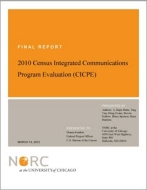
An official website of the United States government
Here’s how you know
Official websites use .gov
A .gov website belongs to an official government organization in the United States.
Secure .gov websites use HTTPS
A lock (
) or https:// means you’ve safely connected to the .gov website. Share sensitive information only on official, secure websites.
-
//
- Census.gov /
- 2010 Decennial Census Program Management /
- 2010 Census Program for Evaluations and Experiments (CPEX) /
- 2010 Census Integrated Communications Program Evaluation (CICPE)
2010 Census Integrated Communications Program Evaluation (CICPE)
2010 Census Integrated Communications Program Evaluation (CICPE)
Overview
The 2010 Decennial Census effort included a broad-based, multi-faceted 2010 Integrated Communications Campaign (ICC) to encourage participation in the Census. Components of the 2010 ICC included paid media advertising, partnership efforts in local communities, a Census in Schools program for outreach to students in elementary and secondary schools, and earned media in traditional and digital media outlets. ICC outreach began in late 2009, with peak paid media and partnership activities taking place from January through June, 2010.
The 2010 Census Integrated Communications Program Evaluation (CICPE) was conducted by NORC (NORC) at the University of Chicago under contract from the Census Bureau to:
- track the evolution of knowledge of and attitudes toward the Census prior to an d during the 2010 Census;
- evaluate the effect of the 2010 ICC on mail return and cooperation with enumerators;
- increase understanding of the mechanisms through which a communications campaign can affect census participation; and
- emphasize the perspectives of hard - to - count groups in achieving these analytical objectives.
This report presents the results of a three - year study that combines survey data with census operational records and a variety of other commercial and administrative data sources to achieve these objectives.
Main findings of the report include:
- Knowledge of the census increased significantly for the U.S. population as a whole and among key subgroups from fall 2009 to late spring 2010. Attitudes toward the census also became more favorable during that period.
- Exposure to the 2010 ICC was quite high for the population as a whole and for key subgroups, particularly through paid media broadcast on television. On average, a national sample of Americans recalled seeing census - related communications about once a week during the spring of 2010.
- Multivariate regressions indicate relationships between campaign exposure and increases in knowledge and attitudes. We establish these relationships through direct estimation as well as through use of message receptivity analysis, a validated approach from the communication sciences literature.
- A consistent finding of this evaluation (and shown in these tables) is that different subgroups vary in their responses to the different components of the campaign . Aside from word of mouth, statistically significant associations between campaign exposure and mail return promote rather than depress mail return.
- Increased campaign exposure is associated with increased mail return and cooperation with enumerators for some subgroups. The associations of greater knowledge with mail return and cooperation with enumerators are often larger in magnitude.
Financial data on investment in the ICC were not sufficiently detailed for use in return on investment calculations within the CICPE design. As an alternative, we estimate lower and upper bound estimates of the change in mail return rate and/ or cooperation with enumerators associated with campaign exposure. We note that the finding of differential effects across subgroups means that the maximal return comes from targeting components to subgroups. Broader implementation of components to subgroups that do not exhibit returns to those components dilutes the overall return to the campaign.
Others in Series
Publication
Publication
Publication
Share
Related Information
Some content on this site is available in several different electronic formats. Some of the files may require a plug-in or additional software to view.
 Yes
Yes
 No
NoComments or suggestions?


Top

